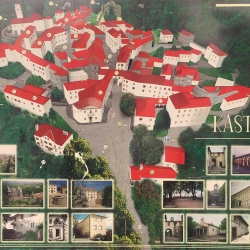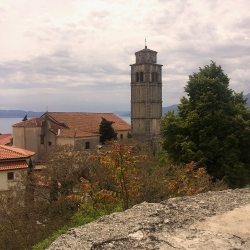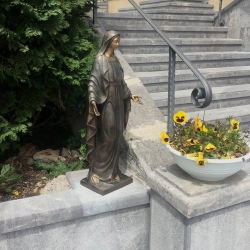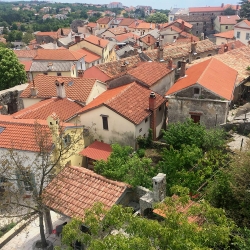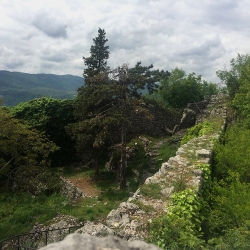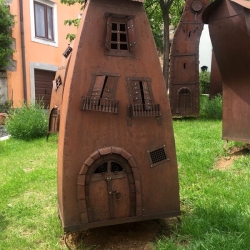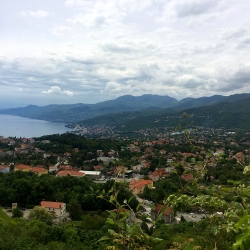Plitvice lakes
Plitvice lakes are considered to be the biggest and most well known National park in Croatia. Its total area is 296,85 km2. The park is secures in the Unesco list.
There are 16 big lakes on the territory and many small lakes connected among each other by waterfalls and water channels. The water in the lakes can be different coloured (blue, navy blue, grey, green). This is explained by the presence of carbonate potassium deposits and specific algae and bacterium.
The surrounding mountains, covered with relic beech and spruce forests are also under park’s prudency. These forests are enriched with different species of flora and fauna. Rare plants and trees such as stone oaks, hornbeams can be found here as well as more than 120 kinds of birds, roe deer, bobcats and even bears.
There are 20 caves in the park as well, the most unique and interesting for visitors are those hidden under waterfalls.
The park offers a range of routes of different lengths: the shortest is for 2 hours when the longest can last until 7-8 hours. An electric train can be used for some of the routes.
Pula
Pula is the biggest city in Istria, located on the western coastline of the island. The history of the city goes back in thousands of years, which according to the legend the city was founded by Argonauts during their trip for the “Golden Fleece”. During the time of Roman Empire Pula was a big prosperous city.
Many ancient roman architectural monuments are still in good condition, the most famous of which is the Amphitheatre Arena. This huge construction can manage up to 23 000 people in the audience. It is also worth seeing the Forum Square with a unique building of communal palace, roman temple of Roma and August, arch of the Sergii. There is a monument early Christian architecture – Pula cathedral. In the geographic centre of the city you can visit the Venetian fortress.
Hum
Hum secured its place in the Guinness World Records as the smallest city in the world where only 17 people live. There are only 20 buildings standing on the streets that are paved with slabs of stone.
Like in any other city Hum has a city hall, post office, two temples, a square, a museum with two halls, wine and souvenir shop as well as two houses where you can rent a room for a night. Tourists love sending cards to their friends from Hum as from the smallest city in the world.
The city hasn’t changed from the XI century. A fortress wall surrounds it, with medieval gates thought where you can get inside the city. It feels as though the time has stopped.
The main city attractions are the church of the assumption of Mary, erected in 1802 and a Church of St. Jerome built in XII century.
Rovinj
It is a romantic city with narrow lanes, situated in western Istria on Adriatic coastline and is one of the 9 biggest cities of the peninsula. The population is around 15 thousand people.
The city can be named “small Croatian Venice” due to walls of the buildings being raised straight from the water.
The main attractions are in the Old City, which is located on a small peninsula in a shape of a water drop. Some of the most precious are: St. Euphemia’s Basilica, 62 metre-high bell tower that can be seen from anywhere of the peninsula, seven angle building – the chapel of the Holy Trinity (XIII century), the city hall on the central Rovinj square, the Church of Our lady of consolation, castle of Caleffi family.
Motovun
Motovun is located on a hill, at the bottom of which the river Mirna is flowing. The longest staircase in Istria of 1052 steps goes to the peak of the hill where the central square of the city is.
Both black and white Istrian truffles grow in the forest of Motovun that is stretched across dozens of kilometres along the river. There is a festival dedicated to truffle hunting in the city, which takes place every October.
There are grapes growing for the famous Istrian wines – Terrano and Malvasia.
The city layout is represented on the 10 Kuna notes.
The city is not very popular among the tourists meaning that you can walk the old beautiful streets in a quiet atmosphere.
Svetvincenat
Svetvincenat, Savicenta or San Vicenti are three names of one small town, located in the center of Istria. It is surrounded by grape and olivewood, along on the way there is Pula – Pazin . Svetvincenat, just like the whole Istria used to belong to Venetian republic for a long time right until it was destroyed by Napoleon in 1797.
The first small settlement where now Svetvincenat is appeared around Benedictine Abbey, founded in the end of the 10th century. A church was built at that time named in the honour of Saint Vincent, which still exists today. In 1314 the abbey was abolished. Since 1560s the territory of Svetvincenat went to the ownership to the Grimani family, the previous owner Morosini didn’t have any male heirs and the inheritance went down the female line, which was related with Grimani.
Now in the guide books the castle is mentioned as the Morosini-Grimani castle. It is one of the best preserved and beautiful castled in Istria.
We came to this town in May. There was no one on the streets. There was a square, a castle, a church and beautiful blooming chestnuts. Behind the church we saw rural residential old houses. The roosters were crowing, the dogs were barking, but still no one to be seen. We walked around a closed castle, looked into lancet holes. Then went into a café, where we met the first local citizen, whom I asked if we could see the castle territory from the inside. He happily hit his knees with the words: ”So, you need the key!”. At that moment it seemed like he would take the key out of his pocket. However, he sent us into the information booth, where a friendly girl got out the key for the castle from the stand (a huge one, about 20 centimeters long) and walked us to the doors. I have tried to buy tickets to view the castle, but it turned out to be free.
The castle was very impressive by how well preserved it was, how massive, beautiful and powerful. After seeing it, we went to the information point again, as we also wanted to see the frescos in the church, but the prior left, who kept the keys from all three churches around had already left. So we had to be satisfied with the information about frescos from the guidebooks.
Veprinac
Veprinac is located on the height of 519 metres on the hills of the Uchka Mountain. It was firstly mentioned in Hugo Devinski’s will in 1374.
For the past century the view on the surroundings hasn’t changed, only the colours have been added to the photographs.
City gates greet the tourists approaching the city. According to several sources, they are dated back by the year 1300, however, the writing in Glagolitic alphabet talks about the year 1574. There is the municipal loggia, a typical Venetian construction of that time located near the gates.
107 steps lead the way from city’ s old gates to the old Roman military settlement and St. Marco’s church.
The trip to Opatija will take around one a half to two hours. It is best to follow the road signs and not go too far afield.
The road is very different along the whole descent.
Kastav
Kastav (Croatian: Kastav, Italian: Castua) is a small city in Primorje-Gorske Kotar County of Croatia.
The city was founded as a fortress with nine towers. From XII the city was governed by an Italian dynasty of counts from a city Duino (Italy). In 1400 the city became controlled by counts of Walse. At that time the Kastav Law of year 1400 was written in the national language, which consolidated the city status as an administrative and a political centre of the end of the XIV century.
Beram
Ancient town of Beram is located in the heart of Istria on top of a hill, surrounded by a picturesque valley.
Beram is one of the oldest continuously populated communities in Istria that has stayed alive for centuries.
The ruins of the wall were used by Romans as a foundation to build their forts and castles much later. A radial street pattern established in the town centuries ago is still preserved and functional.
Beram was one of the most important centres of medieval Cyrillic alphabet, the Glagolitsa. The priests of Beram taught literacy to eager learners from all over Istria. The testimonials of it were left on the margins of the Beram liturgical books, and carved on the frescoes of the little church of St. Mary on the Rocks. The frescoes inside the church were painted by Vincent from Kastav in 1475. They are preserved until today, although not intact, but certainly magnificent! The most famous is “The Dance of Death”, depicting the morbid dance of various characters surrounded by skeletons — a king, a queen, a knight, a pope, a merchant, a woman, a child. It is a very powerful allegory of the fact that death spares no one. Neither wealth or status or age have any significance to death. The dramatic fresco serves as a memento that all must die.
The key to the church is kept by the Gortan family, in the village nearby. It is recommended to arrange a visit beforehand by a phone call.
There is an authentic tavern located in Konoba Vela Vrata village. If the weather allows, it is most advisable to sit outside on the terrace and marvel at the views of the neighbouring fields and forests. The key feature of the tavern is an open fire grill. It is easy to envision the life of a medieval farmer when eating grilled mushrooms followed by a piece of mouthwatering lamb. All dishes are served on wooden boards and it only makes the whole experience more authentic and rustic.



